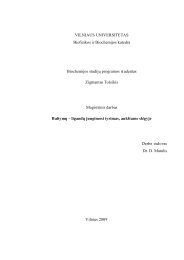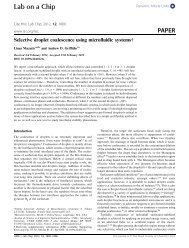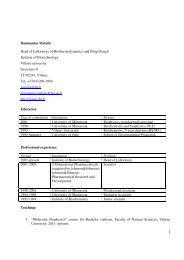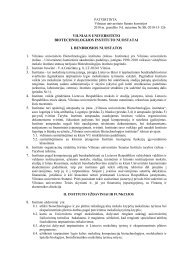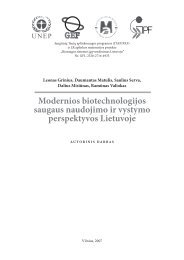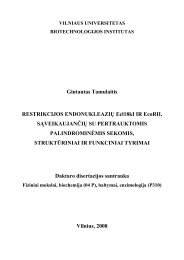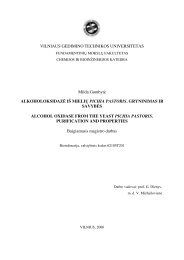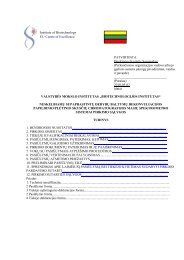Report 2008-2010
Report 2008-2010
Report 2008-2010
You also want an ePaper? Increase the reach of your titles
YUMPU automatically turns print PDFs into web optimized ePapers that Google loves.
Structure and function of restriction endonucleases: projects<br />
overview<br />
DNA synapsis through transient tetramerization triggers cleavage<br />
by Ecl18kI restriction enzyme.<br />
To cut DNA at their target sites, restriction enzymes assemble into different<br />
oligomeric structures. The Ecl18kI endonuclease in the crystal is<br />
arranged as a tetramer made of two dimers each bound to a DNA<br />
copy. However, free in solution Ecl18kI is a dimer. To find out whether<br />
the Ecl18kI dimer or tetramer represents the functionally important assembly,<br />
we generated mutants aimed at disrupting the putative dimerdimer<br />
interface and analysed the functional properties of Ecl18kI and<br />
mutant variants. We show by atomic force microscopy that on twosite<br />
DNA, Ecl18kI loops out an intervening DNA fragment and forms<br />
a tetramer. Using the tethered particle motion technique, we demonstrate<br />
that in solution DNA looping is highly dynamic and involves a<br />
transient interaction between the two DNA-bound dimers. Furthermore,<br />
we show that Ecl18kI cleaves DNA in the synaptic complex<br />
much faster than when acting on a single recognition site. Contrary to<br />
Ecl18kI, the tetramerization interface mutant R174A binds DNA as a<br />
dimer, shows no DNA looping and is virtually inactive. We conclude<br />
that Ecl18kI follows the association model for the synaptic complex assembly<br />
in which it binds to the target site as a dimer and then associates<br />
into a transient tetrameric form to accomplish the cleavage<br />
reaction.<br />
Figure 2. Reaction pathway of the Ecl18kI restriction<br />
enzyme on the two-site DNA. At<br />
Ecl18kI concentrations much below that of the<br />
DNA, a single Ecl18kI dimer presumably binds<br />
to only one individual target site. Binding of<br />
the second dimer at increased enzyme concentrations<br />
produces an unlooped protein-<br />
DNA complex, where two dimers act on the<br />
two DNA sites independently. Tetramerization<br />
of two DNA-bound Ecl18kI dimers results in<br />
the looped synaptic complex, which is optimal<br />
for catalysis and gives in fast cleavage.<br />
A novel mechanism for the scission of double-stranded DNA: BfiI<br />
cuts both 3'-5' and 5'-3' strands by rotating a single active site.<br />
Metal-dependent nucleases that generate double-strand breaks in<br />
DNA often possess two symmetrically-equivalent subunits, arranged<br />
so that the active sites from each subunit act on opposite DNA<br />
strands. Restriction endonuclease BfiI belongs to the phospholipase<br />
D (PLD) superfamily and does not require metal ions for DNA cleavage.<br />
It exists as a dimer but has at its subunit interface a single active<br />
site that acts sequentially on both DNA strands. The active site contains<br />
two identical histidines related by 2-fold symmetry, one from<br />
each subunit. This symmetrical arrangement raises two questions: first,<br />
what is the role and the contribution to catalysis of each His residue;<br />
secondly, how does a nuclease with a single active site cut two DNA<br />
strands of opposite polarities to generate a double-strand break. In<br />
this study, the roles of active-site histidines in catalysis were dissected<br />
by analysing heterodimeric variants of BfiI lacking the histidine in one<br />
subunit. These variants revealed a novel mechanism for the scission<br />
of double-stranded DNA, one that requires a single active site to not<br />
only switch between strands but also to switch its orientation on the<br />
DNA.<br />
Figure 3. A model for the reactions of WT BfiI on the bottom and the top<br />
strand of a DNA duplex. The H105 residue from the same subunit of the<br />
homodimer, the 2° subunit not bound to the DNA makes the nucleophilic<br />
attacks on the target phosphodiester bonds in both bottom and top strands<br />
of the DNA. To match the anti-parallel orientation of the two strands, the<br />
N-terminal domains of BfiI must rotate by 180° between the two hydrolysis<br />
reactions.<br />
35 th anniversary<br />
18




